Gotland is a special destination for Swedes, and the mention of its name brings a knowing smile to their faces, and remarks like “it’s a beautiful place”, or “it’s so nice there”. Gotland is an island on the east coast of Sweden steeped in history, picturesque scenery, a relatively mild climate, and a great place to visit for a week or more.
How to Get There
To get to Gotland there are two options – by boat or place. Most people arrive by the ferry from Nynäshamn, however there is an airport on the island, and of course if you have your own boat you can travel and dock there.
Ferry from Nynäshamn
Nynäshamn is about 45 minutes drive south of Stockholm, and about 1 hour by train. It serves as the main ferry terminal between the mainland of Sweden and Gotland. It is a small town on the east coast, and if you have the time you can stay there overnight before heading the ferry to Gotland.
There are 2-3 departures per day depending on the season, and the journey takes about 3 hours. It is a nice try when the weather is fine. Although not essential, we recommend that you book your seats when you buy your ticket. There are special areas if you have a pet. There is food and drinks available to purchase on board.
Book your tickets through Destination Gotland.
Fly
The airport on Gotland is close to Visby, and there are regular flights to Visby from Stockholm’s Arlanda and Bromma airports, and Helsinki in the summer months. The main airlines are SAS, BRA, Norwegian, Finnair and Ryanair.
Visby
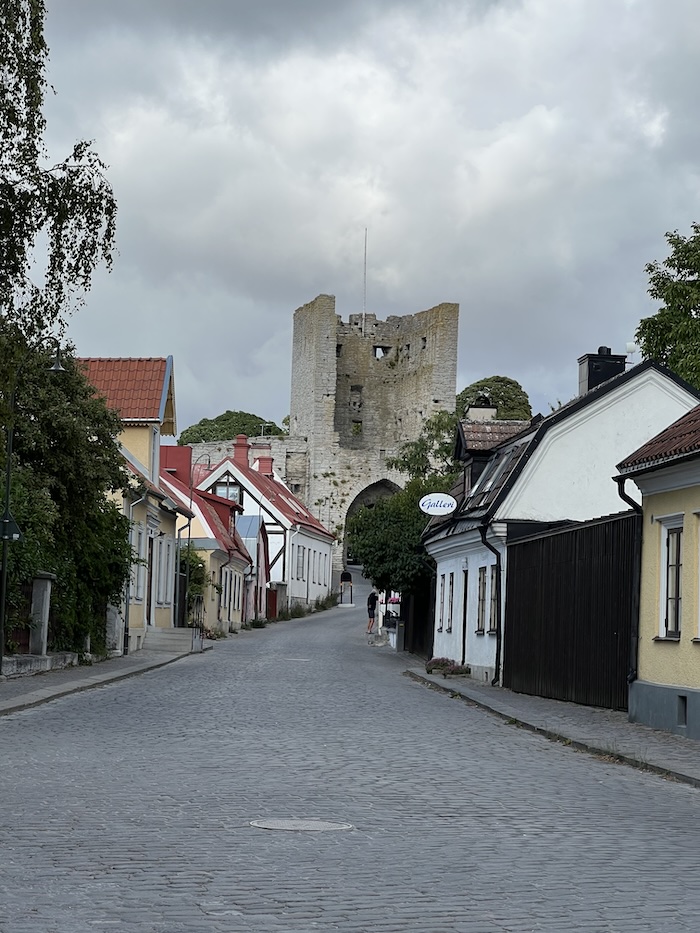
The city of Visby is a UNESCO world heritage site, and so is rich in history and culture, and is a well-preserved Hanseatic city, complete with city walls, churches and other significant buildings, in fact there are more than 200 buildings dating back to the 1200s and 1400s.
It is a beautiful city to visit, explore and experience. While just being there is a great experience in itself, these are the main places to visit:
Visby City Walls
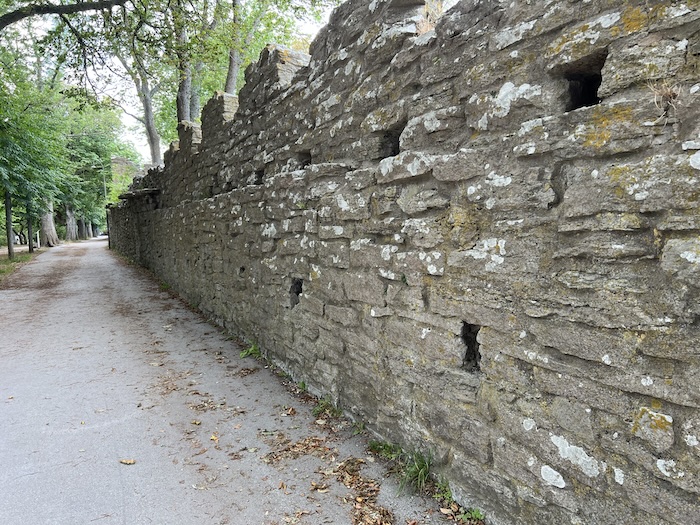
Being a wealthy and important trading city, Visby needed to fortify itself again attacks from both the sea and land. Visby has about 3.5 km of the old city walls and towers in place, with some towers dating back to the 1200s. There are walking tracks beside some sections, and a good point to see it is to start at the car park on the corner of Österväg and Kung Magnus väg, and then walk to Norderport.
Gotland Museum
Like many historic cities, the Gotland Museum (Fornasalen) is a great place to start, and learn about the history and the people of the island, and the city. Although Visby is part of Sweden, and close the mainland, its position in the Baltic, and its climate have moulded it into a unique island. The museum contains important relics and history from the stone age, the Viking period, through to modern times. If you see an interesting object and want to learn more, the museum contains and database with information about each of their objects.
Botanic Garden
Visby 2.5 hectare Botanic Garden was established in 1855 and contains both exotic plants and plants native to the island. It is free to enter the garden, and a lovely place to relax and enjoy a break from sightseeing.
Churches in Visby

St Mary’s Cathedral
This stunning mediaeval cathedral was originally built for German traders, and since its building has been a feature of the Visby city and skyline. It is constructed from limestones local to Gotland, with wooden spires. It was originally smaller, and has been extended and renovated over the years, which is why it is better preserved that some of the other churches on the island.
St Karins
These church ruins are on the main square, and after you’ve entered the old town through the city walls it feels like another step back into the history of the city. The church has beautiful arches and columns, giving you a sense of craftsmanship that went into its creation.
St Nikolai
This church, now partially ruined, but still in use now as a concert hall, was built in around 1220-1230, and is named after St Nicholas – the patron saint of sailors and merchants. It is located near to the Botanic Gardens.
Where to Eat in Visby
Restaurang Torgkrogen
This is a fairly typical Swedish restaurant in a nice rustic setting, that serves up some local dishes, such as saffron pancakes. It has mixed reviews on other sites, but we found the food pretty and the service fine.
Plaza Restaurant and Pub
This is a popular restaurant right on the main square, and on a warm summer’s day is the perfect place to have a long lunch or dinner. The food is well prepared and served – and they serve popular dishes, some Swedish, some not. This place is pretty popular and does get busy, so I recommend booking in advance.
Glassmagasinet
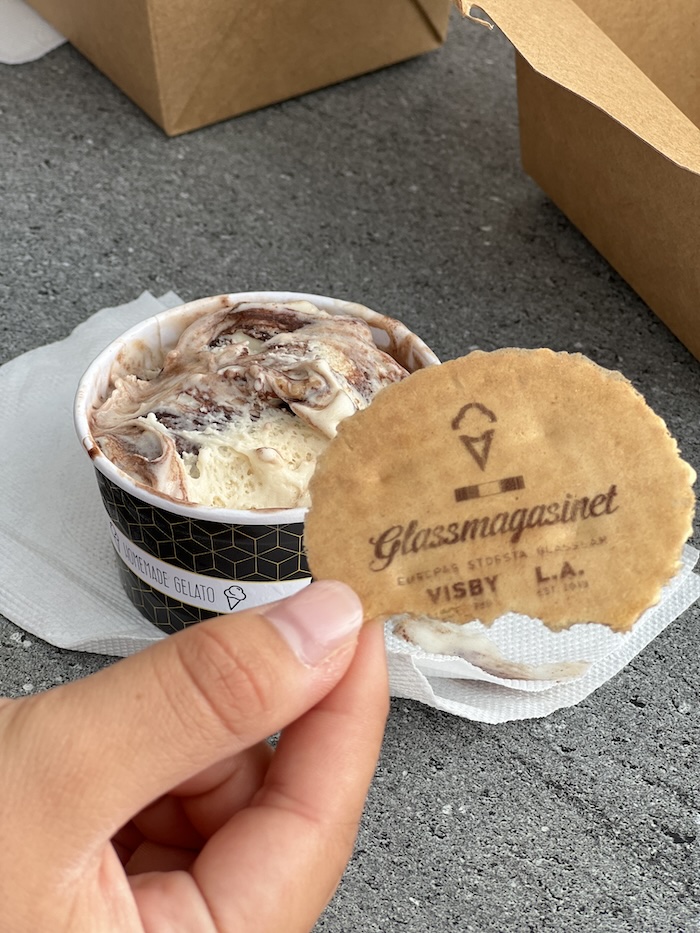
This ice cream and gelato cafe’s claim to fame is that it has the largest selection of ice cream and gelato – they have a selection of over 345 flavours, with 260 on offer at any one time. In the summer it is very popular, which you’d expect. Their selection is huge, and it is not limited to ice cream – it is a cafe as well. Glassmagasinet’s ice cream and gelato is great, and well worth a stop when you’re in Visby.
Recommend Foods to Try in Gotland
Kajp Soup: This soup is made from a local variety of leek that grows wild on the island.
Smoked Flounder: This fish dish of smoked flounder is served with a potato salad.
Glödhoppa: This is a dish prepared from lamb – the bones are removed, and then it is coated in breadcrumbs and mustard, and then sauteéd.
Saffron pancakes: Although they are called pancakes, they are very different from the thin pancakes popular in Sweden – it is thicker, and made from rice pudding, cream, milk, sugar, egg, chopped almonds, and saffron.
Stavgard Viking Village and Beowulf’s Longhouse
Stavgard Viking Village is a recreated Viking village, in an area where there are ruins dating back to the Iron Age. The Viking Village includes a few typical buildings from the Viking Age, typical fences, and then demonstration of crafts from the era. Each day there is a short tour and stories about Store Stavar, a Viking Chieftain. You can try traditional archery, or some of the crafts, and just relax and have lunch. On Fridays and Saturdays there is a mock fight, and then during Viking Week (towards the end of July and beginning of August), the place is filled with people dressed a vikings and people from that era.
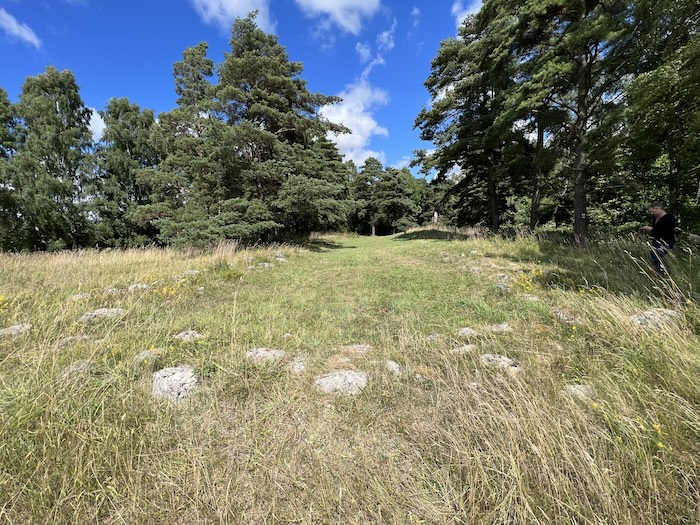
Near to the Viking Village is the ruins of one of the largest Iron Age longhouses in Europe, and it is thought to be the home of Beowulf – the legendary character in the poem of the same name. This is within walking distance from the Viking Village.
Mediaeval Week – Medeltidsveckan – in Gotland
For one week in the beginning of August, Visby, plus some of the other parts of Gotland are filled with mediaeval reenactments, food, lectures and workshops. Every year there is a different theme (for example in 2024 is it the horse). The mediaeval week has been running since 1984 and is Europe’s largest historical festival. It is a very popular festival, so booking ahead for accommodation and events is highly recommended.
Högklint
Högklint is a lovely place for a walk, with spectacular views over the coastline of Gotland. It is located about 15 km south of Visby, and is famous for its lookout, but is a nice place to stop and take a walk, taking in the views of the cliffs of the area, and of Visby to the north.
Tofta Strand Beach
Toft Strand or Tofta Beach is a great beach, and very popular with locals and visitors to the island. There are lots of activities located here, plus a few different accommodation options, such as camping, cabins, and a pension – Tofta Strandpensionat.
Fårö (Sheep Island)
Fårö is an island to the north of Gotland that makes for the perfect day trip, but you could easily spend a few days here as well. It is even more relaxed and rural than Gotland, with some unique scenery and great beaches.
To get there, take the ferry from Fårösund – it is a short trip across, and the ferries run constantly in the summer months. The island is sparsely populated, but there is accommodation on the island, as well as camping, restaurants and supermarkets.There are only a few main roads on the island.
Digerhuvud
Weathered sea stacks, or rauks, are one of the main reasons people make the trip to the island. Digerhuvud is the area with many of them. On the western side of island, this quiet location by the sea features many rauks, and have picnic tables, making it a nice place to stop.
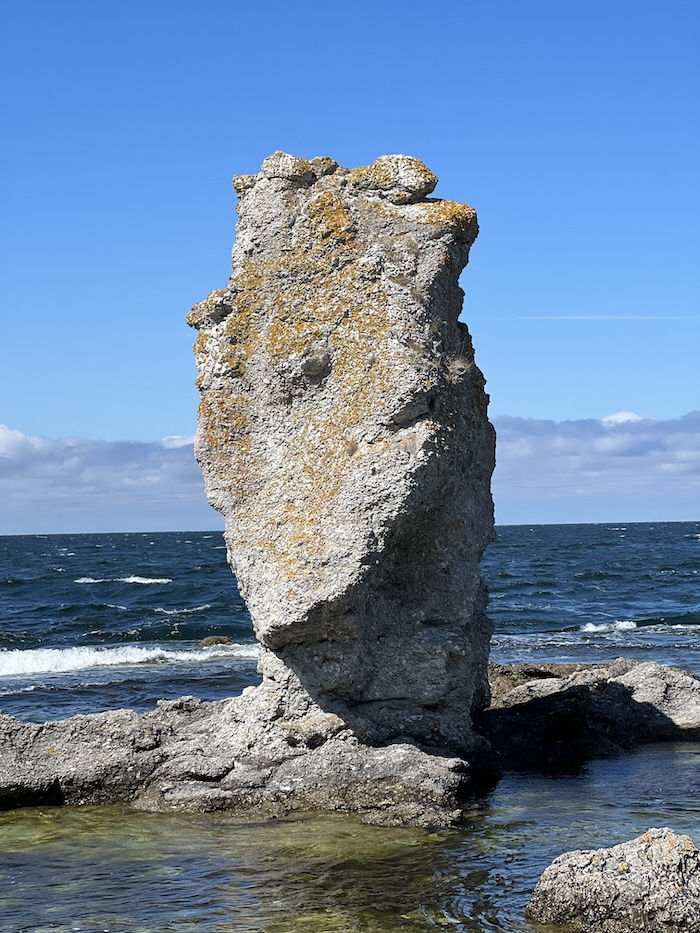
Norsta Auren
Fårö has some nice beaches, one in particular is Norsta Auren at the north of the island. It is a long, sandy beach, something you don’t normally associate with Sweden. In the summer it is a nice place to relax and take a dip in the Baltic Sea. There are a few access points to the beach, the most convenient being Holmudden, near the lighthouse. We found a spot about halfway along the beach, and then walked through the forest to the beach.
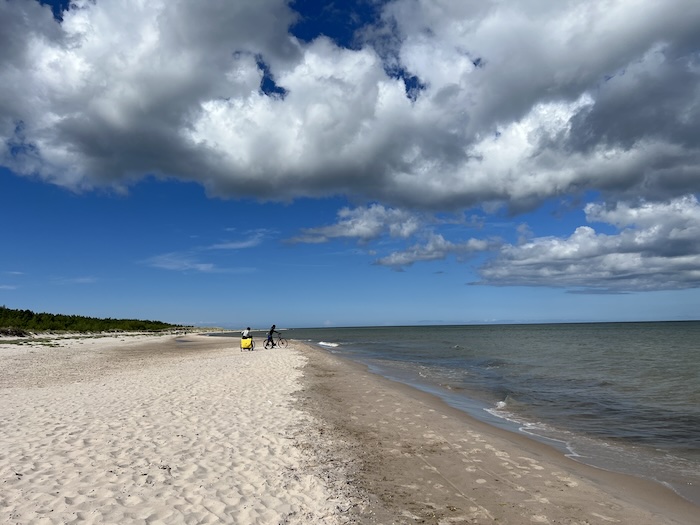
Where to Eat on Fårö
Pasta Makers (Pastamakarna)
This restaurant is based around the simple concept of serving sustainably produced pasta, made from local ingredients. Their menu is simple – pasta of the day with a variety of sauces, including a vegan option, and special servings for children. They also sell dried pasta for you to take home to cook and enjoy later.
Website: https://pastamakarna.se/
Address: FÅRÖ LANSA 1066, 624 66 Fårö
Phone: 0708-144689